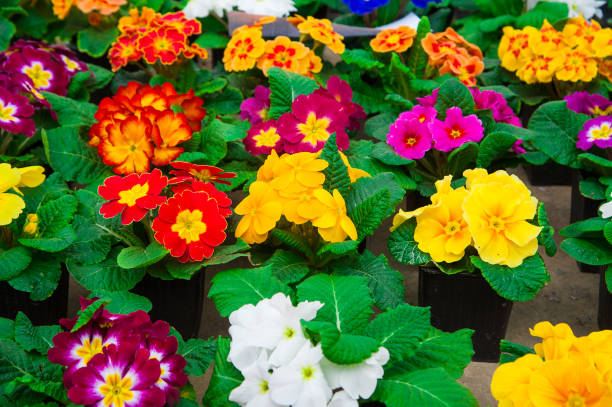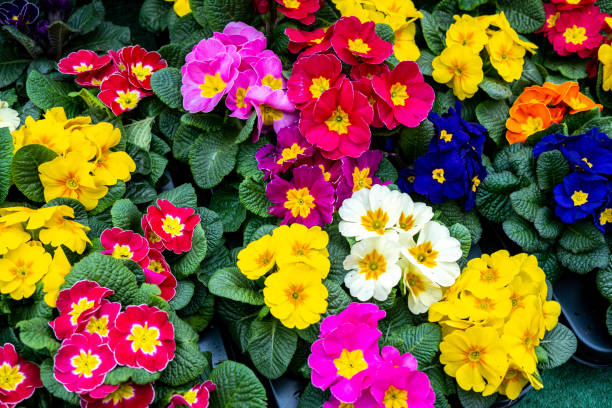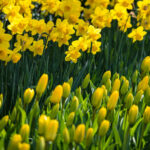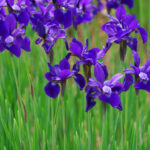Primrose flowers (Primula spp.) are among the earliest blooms of spring, symbolizing new beginnings, hope, and youth. Their vibrant colors and cheerful appearance make them a favorite in gardens and floral arrangements. The genus Primula, which includes over 400 species, is native to the Northern Hemisphere and can be found in a range of habitats, from alpine regions to woodlands and riverbanks. The word “primrose” itself is derived from the Latin primus, meaning “first,” a fitting name for a flower that is one of the first to bloom in spring.
In this article, we will explore everything there is to know about primrose flowers: their history, symbolism, varieties, growing conditions, and care. Whether you’re a seasoned gardener or a flower enthusiast, primroses can bring color and vitality to your garden or home.


History and Symbolism of Primrose Flowers
Primroses have a rich history and are steeped in folklore and symbolism. They have been admired for centuries for their delicate beauty and are often seen as harbingers of spring.
1. Symbolism of Primroses
Primroses have various meanings depending on the culture, but they are generally associated with youth, renewal, and love.
- New Beginnings: As one of the first flowers to bloom in spring, primroses symbolize the return of life after winter. Their appearance heralds the coming of warmer weather and the promise of growth and renewal.
- Love and Devotion: In the Victorian language of flowers, primroses represented young love and affection. Giving someone a bouquet of primrose was seen as a declaration of love, indicating that the giver couldn’t live without the recipient. The delicate beauty of the primrose flower was thought to mirror the tender emotions of first love.
- Protection and Healing: In Celtic mythology, primroses were believed to offer protection from evil spirits. They were sometimes planted near doorways or placed in homes to ward off negative energies. The flowers were also used in traditional medicine and believed to have healing properties for ailments such as insomnia, headaches, and arthritis.
2. Folklore and Myths
In addition to their symbolic meanings, primroses are also associated with various legends and myths. In some European countries, primroses were linked to fairies, and it was said that if you placed a key made of primroses on a rock, it would open the door to the fairy realm. This connection to magical beings and the idea of hidden worlds made primroses a subject of intrigue and wonder.
In Christian symbolism, primroses were associated with the Virgin Mary and were often referred to as “Mary’s Key” in medieval England, as they were believed to symbolize the opening of the gates to heaven.
Varieties of Primrose Flowers
The Primula genus is vast, containing over 400 species, each with its unique characteristics. Some varieties are better suited to alpine environments, while others thrive in woodland settings or as garden plants. Below are some of the most popular types of primroses.
1. Common Primrose (Primula vulgaris)
The common primrose is native to Europe and is one of the earliest spring bloomers. Its pale yellow flowers, which are often fragrant, are a familiar sight in woodlands and meadows. This species is a low-growing plant, forming rosettes of dark green leaves that serve as a backdrop to its delicate blooms. It thrives in partial shade and well-drained soil, making it a perfect addition to woodland gardens.
2. Cowslip (Primula veris)
Cowslips are closely related to the common primrose and are easily recognizable by their clusters of bright yellow, nodding flowers that appear in spring. Each flower is tube-shaped with orange spots in the throat. Cowslips prefer sunny or partially shaded areas and can often be found in meadows and along roadsides. They have been a part of traditional medicine for centuries and were once used as herbal remedies for coughs and colds.
3. Polyanthus Primrose (Primula × polyantha)
Polyanthus primroses are hybrids derived from crossing the common primrose with other species. These primroses are prized for their vibrant colors and their ability to bloom in a wide range of conditions. Polyanthus primroses come in shades of red, purple, pink, yellow, and blue, with many bicolored varieties available. They are popular in garden beds, containers, and borders, providing a burst of color during the cooler months.
4. Primula Auricula
Auricula primroses are known for their eye-catching flowers, which come in a range of bold colors and feature contrasting centers. Native to the European Alps, these primroses are hardy and thrive in rock gardens or alpine environments. Their blooms, which appear in spring and early summer, often have a waxy texture, giving them a unique appearance compared to other primrose species.
5. Japanese Primrose (Primula japonica)
The Japanese primrose is a striking plant with tall, elegant stems and tiers of brightly colored flowers. This variety is native to Japan and thrives in damp, woodland settings or along stream banks. Japanese primroses are often grown in moist, shady garden areas, where they add vertical interest and color.
6. Drumstick Primrose (Primula denticulata)
The drumstick primrose gets its name from its spherical flower heads, which sit atop tall, sturdy stems. These globular clusters of blooms range in color from purple and pink to white. The plant’s dense rosettes of leaves grow close to the ground, while the flower stems rise above, creating a dramatic effect in the garden. This species is native to the Himalayas and prefers cool, moist conditions.
Growing and Caring for Primrose Flowers
Primroses are relatively easy to grow and care for, making them an excellent choice for both beginner and experienced gardeners. Whether grown in pots, garden beds, or woodland settings, primroses add vibrant color and beauty to the landscape. Below are key tips for growing and caring for primrose flowers.
1. Choosing the Right Location
Primroses thrive in areas that receive partial shade to full shade. While some species, like cowslips, prefer sunnier locations, most primroses do best in shady, woodland-like conditions. A location that gets morning sun and afternoon shade is ideal. In hotter climates, it’s important to protect primroses from harsh, direct sunlight, which can scorch the leaves and reduce blooming.
2. Soil Requirements
Primroses prefer moist, well-drained soil that is rich in organic matter. A slightly acidic to neutral soil pH (around 6.0 to 7.0) is ideal for growing healthy primroses. Adding compost or well-rotted manure to the soil before planting will help improve its structure and nutrient content. Primroses do not tolerate waterlogged soil, so good drainage is essential to prevent root rot.
3. Planting Primroses
Primrose can be planted in the spring or fall, depending on the species. If planting from seed, it’s best to start them indoors in late winter and transplant them outdoors after the danger of frost has passed. Primrose seeds need light to germinate, so they should be sown on the soil surface rather than buried. Space the plants 6 to 12 inches apart, depending on the variety, to allow for proper air circulation and growth.
For container-grown primroses, choose pots with good drainage and use a high-quality potting mix. Container plants should be watered regularly to keep the soil moist but not soggy.
4. Watering and Moisture
Primroses require consistent moisture, especially during their active growing and blooming periods. Keep the soil evenly moist, but avoid overwatering, as this can lead to root rot. Mulching around the plants can help retain moisture and keep the soil cool, especially in warmer climates.
In particularly dry or hot conditions, it’s important to increase watering to ensure the plants don’t dry out. However, always allow the top inch of soil to dry out slightly between waterings to prevent waterlogging.
5. Fertilization
Primroses benefit from regular fertilization to promote healthy growth and abundant flowering. Use a balanced, slow-release fertilizer or a water-soluble fertilizer with equal parts nitrogen, phosphorus, and potassium. Fertilize once every four to six weeks during the growing season. Avoid over-fertilizing, as this can lead to excessive leaf growth at the expense of flowers.
6. Pruning and Deadheading
Deadheading, or removing spent flowers, encourages primroses to continue producing blooms throughout the season. Regularly check for faded flowers and trim them off at the base of the stem. Pruning away yellowing leaves or damaged stems also helps maintain the plant’s appearance and health.
Primroses in Garden Design
Primroses are highly versatile and can be used in various ways to enhance garden landscapes. Their bright, cheerful flowers and ability to thrive in shady areas make them perfect for woodland gardens, borders, and container plantings.
- Woodland Gardens: Primroses are ideal for creating a naturalistic woodland garden. Plant them among ferns, hostas, and other shade-loving perennials for a lush, layered effect. The bright colors of primrose blooms will stand out against the green foliage, adding interest and beauty to shaded areas.
- Garden Borders: Use primroses to edge garden borders or pathways, where their vibrant blooms will provide a splash of color. Polyanthus primroses are particularly effective in this role,







